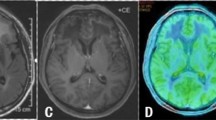Abstract
33 cases of adrenoleukodystrophy in children have been studied. Brain MRI was performed in these patients in order to appreciate the benefits of this technic in patients presenting with the cerebral type of ALD [21]. 12 neurologically asymptomatic patients with the same biochemical disorder were studied. In both groups, MRI is the best imaging modality. In symptomatic patients lesions were clearly demonstrated with excellent clinical correlations. In addition, MRI can depict brain lesions in asymptomatic patients before devastating brain damage occurs. MRI is the essential step before proposing specific treatment to these patients.
Similar content being viewed by others
References
Moser HW, Moser AE, Singh I, O'Neill BP (1984) Adrenoleukodystrophy: survey of 303 cases-biochemistry, diagnosis and therapy. Ann Neurol 16:628
Moser HW, Naidu S, Kumar AJ, Rosembaum AE (1987) The adrenoleukodystrophies. Crit Rev Neurol 3:29.
Molzer B, Bernhelmer H, Budka H, Pilz P, Toifl K (1981) Accumulation of VLCFA in common to 3 variants of adrenoleukodystrophy (ALD) “classical ALD”, atypical ALD (femal patient) and adrenomyeloneuropathy. J Neurol Sci 51:301
Moser HW, Naidu S, Fumar AJ, Rosembaum AE (1987) Adrenoleukodystrophy: toward a biochemical definition of a disease with varied presentations. CRC Crit Rev Neurobiol 31:29
Aubourg P, Diebler C (1982) Adrenoleukodystrophy: its diverse CT appearances and an evolutive or phenotypic variant—the leukodystrophy without adrenal insufficiency. Neuroradiology 24: 33
Asho K, Kumar MD, Arthur E, Rosembaum MD (1987) Adrenoleukodystrophy: correlating MR Imaging with CT. Radiology 165:497
Kumar AJ, Rosembaum AE, Naidu S, Wener L, Citrim CM, Lindemberg R, Kim WS, Zinreich SJ, Molliver ME, Maybergh S, Moser HW (1987) Role of magnetic resonance imaging in adrenoleukodystrophy. Radiology 165:497
Moser et al. (1984). Bone marrow transplantation in adrenoleukodystrophy. Neurology 34:1410
Weihberg K, Moser A, Watkins P, Leharsky C, Winter S, Moser HW, Parkman R (1988) Bone marrow transplantantation for adrenoleukodystrophy. Pediatr Res 23:334A
Aubourg P, Blanche S, Jambaque I, Rocchiccioli F, Kalifa G, Naud-Saudreau C, Rolland MO, Debre M, Chausain JL, Griscelli C, Fischer A, Bougneres JF (1990) Reversal of early neurologic and neuroradiologic manifestations of X-linked adrenoleukodystrophy by bone marrow transplantation. N Engl J Med 322: 1860
Aubourg P, Sellier N, Chausain JL, Kalifa G (1989) MRI detects cerebral involvement in neurologically asymptomatic patients with adrenoleukodystrophy. Neurology 39:1619
Author information
Authors and Affiliations
Rights and permissions
About this article
Cite this article
Pasco, A., Kalifa, G., Sarrazin, J.L. et al. Contribution of MRI to the diagnosis of cerebral lesions of adrenoleukodystrophy. Pediatr Radiol 21, 161–163 (1991). https://doi.org/10.1007/BF02011036
Issue Date:
DOI: https://doi.org/10.1007/BF02011036




